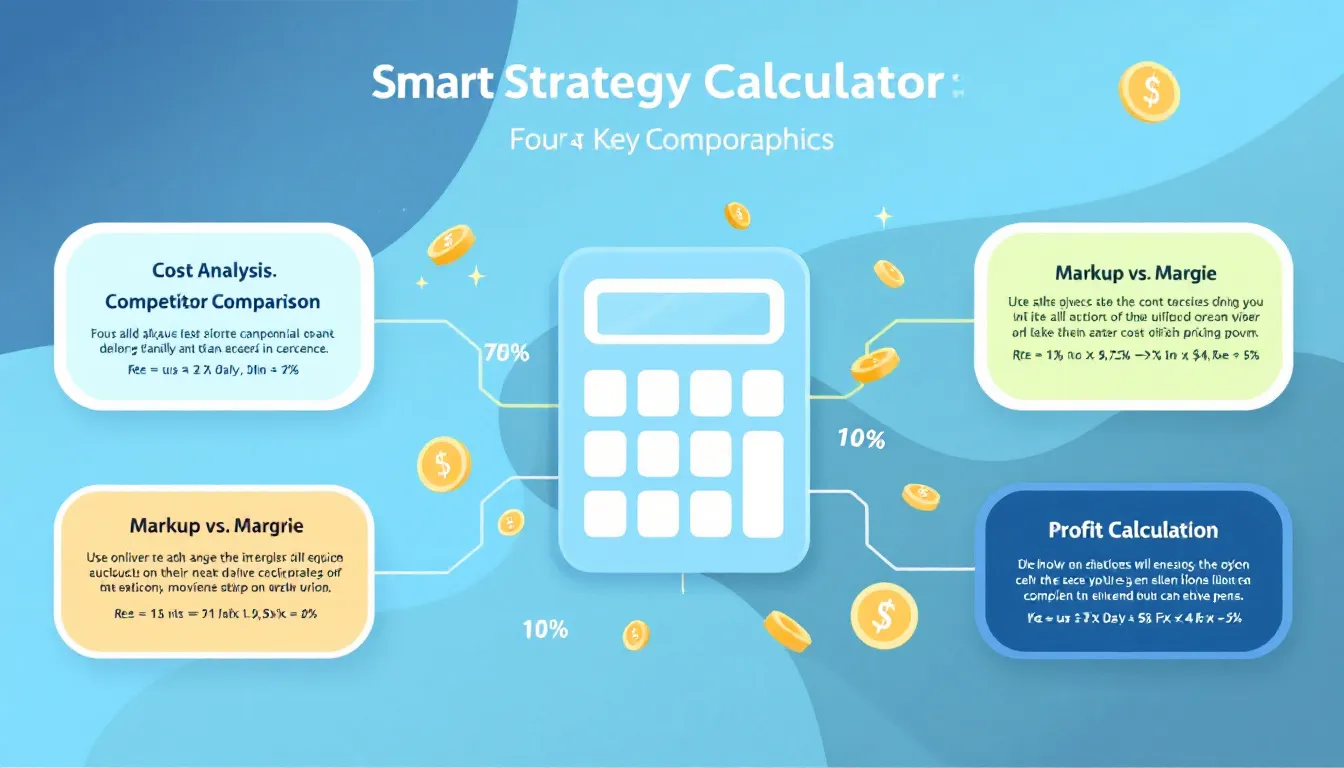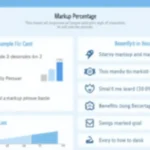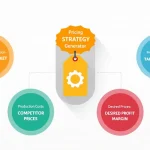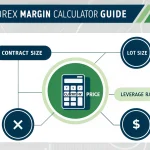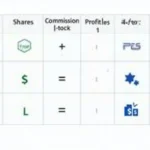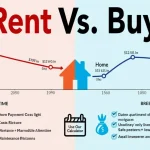Is this tool helpful?
How to Use the Competitive Price Analysis Calculator Effectively
This pricing calculator helps you set smart prices by comparing your costs and competitor prices. Follow these simple steps to use the tool and get accurate pricing insights:
- Enter Cost Price: Type in your product’s production or purchase cost. For example, if you manufacture a smartwatch for $120, or buy handcrafted furniture items for $250 each.
- Add Competitor Prices: Input prices from your competitors’ similar products. Click the Add Competitor button to add multiple prices. For instance, enter $135.99, $142.50, and $129.00 for three different competitors when analyzing a wearable tech market.
- Specify Markup Percentage (Optional): Provide your desired markup. For example, 30% for premium gadgets or 12% for bulk items with tight margins.
- Input Profit Margin Percentage (Optional): Alternatively, enter your target profit margin. For example, 25% for boutique products or 15% for volume-driven sales.
What Is the Competitive Price Analysis Calculator and Why Use It?
The Competitive Price Analysis Calculator is a practical tool designed to help you find the best pricing strategy based on your costs and the market. By combining competitor prices with your desired profit goals, you make informed pricing decisions that strengthen your position and improve profitability.
Purpose and Benefits of the Price Analysis Calculator
- Helps you compare your costs with competitor pricing to position your product effectively.
- Simplifies pricing decisions using calculations based on markup and profit margin strategies.
- Displays instant, easy-to-understand price comparisons with clear results and charts.
- Allows flexibility by letting you choose either markup percentage or profit margin for pricing.
Core Calculations Behind the Calculator
The tool relies on clear financial formulas to provide pricing suggestions. Here are the key formulas it uses:
Average competitor price helps you understand market pricing trends:
$$ \text{Average Competitor Price} = \frac{\sum \text{Competitor Prices}}{\text{Number of Competitors}} $$If you choose markup based pricing, it calculates as:
$$ \text{Markup Based Price} = \text{Cost Price} \times \left(1 + \frac{\text{Markup Percentage}}{100}\right) $$For profit margin based pricing, the formula is:
$$ \text{Margin Based Price} = \frac{\text{Cost Price}}{1 – \frac{\text{Profit Margin Percentage}}{100}} $$Profit per unit shows your profit after costs:
$$ \text{Profit per Unit} = \text{Selling Price} – \text{Cost Price} $$Example Calculations Using the Competitive Price Analysis Calculator
Example 1: Pricing a Specialty Coffee Maker
- Cost Price: $75
- Competitor Prices: $120, $130, $115
- Markup Percentage: 40%
First, calculate the average competitor price:
$$ \text{Average Competitor Price} = \frac{120 + 130 + 115}{3} = 121.67 $$Suggested price with markup:
$$ \text{Selling Price} = 75 \times (1 + 0.40) = 105.00 $$You see that your price of $105 is below the market average of $121.67, allowing room to attract buyers.
Example 2: Setting Consulting Service Rates
- Cost per Hour: $90
- Competitor Rates: $180, $190, $210
- Profit Margin Percentage: 50%
Calculate the average competitor rate:
$$ \text{Average Competitor Price} = \frac{180 + 190 + 210}{3} = 193.33 $$Calculate service rate based on profit margin:
$$ \text{Selling Price} = \frac{90}{1 – 0.50} = 180.00 $$Your rate of $180 matches closely with competitors, ensuring you remain competitive while meeting profit goals.
Key Advantages of Using This Price Analysis Calculator
Strategic Benefits
- Base pricing decisions on real competitive data and your costs
- Visualize your price versus competitors with clear interactive charts
- Switch easily between markup or profit margin pricing approaches
- Instantly calculate profits per unit for better financial insights
Operational Benefits
- Quicker pricing analysis saves time usually spent on manual calculations
- Helps identify pricing gaps and opportunities in your market
- Supports better competitive positioning with data-backed pricing
- Simplifies profit optimization for each product or service
Practical Applications Across Different Industries
Retail Product Pricing Example
Consider a company pricing handcrafted candles:
- Cost Price: $20
- Competitor Prices: $35, $30, $38, $33
- Desired Markup: 50%
Average competitor price calculation:
$$ \text{Average Competitor Price} = \frac{35 + 30 + 38 + 33}{4} = 34.00 $$Suggested price by markup:
$$ \text{Selling Price} = 20 \times (1 + 0.50) = 30.00 $$This pricing positions you competitively without sacrificing your desired profit margin.
Service-Based Business Use Case
Imagine a digital marketing firm setting campaign fees:
- Cost per Campaign: $1,200
- Competitor Campaign Prices: $1,500, $1,600, $1,450
- Profit Margin Goal: 30%
Calculate average competitor price:
$$ \text{Average Competitor Price} = \frac{1,500 + 1,600 + 1,450}{3} = 1,516.67 $$Suggested price based on profit margin:
$$ \text{Selling Price} = \frac{1,200}{1 – 0.30} = 1,714.29 $$The calculator helps you see that your price is above competitors, reflecting a premium service offering.
Frequently Asked Questions About Competitive Pricing
Which pricing method should I use: markup or margin?
Use markup to add a simple percentage on top of your cost. Choose margin when you want a specific profit percentage of your final selling price. Margin pricing suits premium or luxury products better.
How many competitor prices should I enter?
Enter at least 3 to 5 competitor prices for a reliable analysis. More competitor data improves the accuracy of your market insights and pricing strategy.
Can I use this calculator for service businesses?
Yes, simply input your service delivery cost and competitor service rates. The tool works equally well for both products and services.
Should I always match the average competitor price?
Not necessarily. Use the average competitor price as a guide, but adjust your price based on your unique value, quality, and target customers.
How often should I update my pricing analysis?
Review your pricing regularly—quarterly for stable markets and monthly in fast-changing industries. Always update after major market or cost changes.
Can I use different currencies?
Yes, but ensure all inputs use the same currency for accurate comparisons. Convert competitor prices if needed before entering them.
How do I handle seasonal price changes?
Run separate analyses for different seasons to reflect demand shifts. Adjust prices accordingly for peak and off-peak periods.
What if competitors offer volume discounts?
Analyze pricing at multiple volume levels separately. Use the calculator to create tiered pricing strategies reflecting those discounts.
Important Disclaimer
The calculations, results, and content provided by our tools are not guaranteed to be accurate, complete, or reliable. Users are responsible for verifying and interpreting the results. Our content and tools may contain errors, biases, or inconsistencies. Do not enter personal data, sensitive information, or personally identifiable information in our web forms or tools. Such data entry violates our terms of service and may result in unauthorized disclosure to third parties. We reserve the right to save inputs and outputs from our tools for the purposes of error debugging, bias identification, and performance improvement. External companies providing AI models used in our tools may also save and process data in accordance with their own policies. By using our tools, you consent to this data collection and processing. We reserve the right to limit the usage of our tools based on current usability factors.
